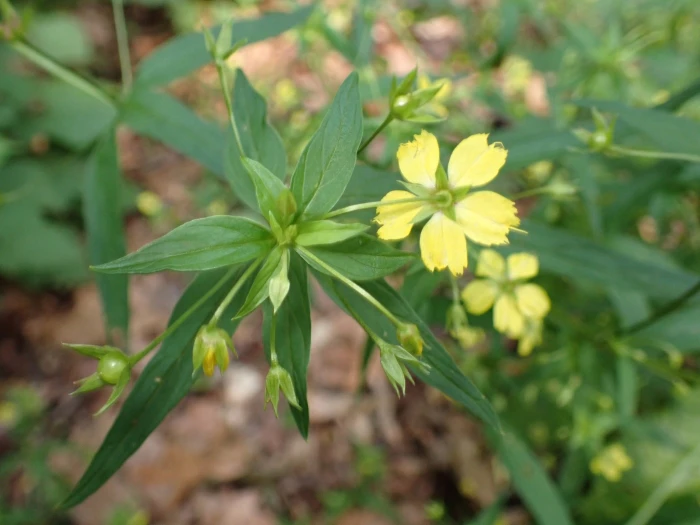Mississippi Loosestrife
(Lysimachia hybrida)
Mississippi Loosestrife (Lysimachia hybrida)
/
/

Sus scrofa
CC BY 4.0
Image By:
Sus scrofa
Recorded By:
Copyright:
CC BY 4.0
Copyright Notice:
Photo by: Sus scrofa | License Type: CC BY 4.0 | License URL: http://creativecommons.org/licenses/by/4.0/ | Rights Holder: Sus scrofa | Publisher: iNaturalist | Date Created: 2023-07-17T14:42:43-07:00 |

























Estimated Native Range
Climate Requirements for Carteret, New Jersey
| This Plant | Your Site | Plant Suitability for Your Location | ||
|---|---|---|---|---|
| • Precipitation | 10" - 62" | 48" | Aquatic | Aquatic |
| • High Temp. | 74°F - 105°F | 86°F | Your summer temperatures are normal for this plant. | Excellent |
| • Low Temp. | -13°F - 43°F | 23°F | Your winter temperatures are normal for this plant | Excellent |
This plant should grow well at your location with about N inches per year (Y minutes per month) of irrigation.
Summary
Lysimachia hybrida, commonly known as Mississippi Loosestrife or Lowland Yellow Loosestrife, is a perennial herb that is native to wetland areas such as marshes, swamps, wet meadows, and stream banks across much of the United States and Canada, excluding the deserts in the west and the Arctic and sub-Arctic regions. This plant typically grows to a height of 1-3 feet (0.3-0.9 meters) and spreads 1-2 feet (0.3-0.6 meters). It features lance-shaped leaves and produces small, star-shaped yellow flowers from early to mid-summer, which are moderately showy and attract pollinators.
Mississippi Loosestrife is valued for its ability to thrive in wet conditions and is often used in rain gardens, water features, and naturalized areas. It is also appreciated for its ease of maintenance and its role in supporting wildlife, such as providing nectar for bees. In cultivation, it requires consistently moist soil and can tolerate partial shade to full sun. While it is not particularly prone to diseases, it can spread aggressively in ideal conditions, potentially crowding out other plants. Gardeners should be cautious of its invasive potential outside its native range and consult local regulations before planting.CC BY-SA 4.0
Mississippi Loosestrife is valued for its ability to thrive in wet conditions and is often used in rain gardens, water features, and naturalized areas. It is also appreciated for its ease of maintenance and its role in supporting wildlife, such as providing nectar for bees. In cultivation, it requires consistently moist soil and can tolerate partial shade to full sun. While it is not particularly prone to diseases, it can spread aggressively in ideal conditions, potentially crowding out other plants. Gardeners should be cautious of its invasive potential outside its native range and consult local regulations before planting.CC BY-SA 4.0
Plant Description
- Plant Type: Herb
- Height: 1-3 feet
- Width: 1-2 feet
- Growth Rate: Moderate
- Flower Color: Yellow
- Flowering Season: Summer, Fall
- Leaf Retention: Semi-deciduous
Growth Requirements
- Sun: Full Sun, Part Shade
- Water: Medium
- Drainage: Medium, Slow
Common Uses
Bee Garden, Bird Garden, Border Plant, Hummingbird Garden, Low Maintenance, Water Garden
Natural Habitat
Native to wetland areas such as marshes, swamps, wet meadows, and stream banks across much of the United States and Canada
Other Names
Common Names: Hybrid Loosestrife, Lowland Yellow Loosestrife, Mississippi Loosestrife, Lance-Leaved Loosestrife, Garden Loosestrife, Lowland Loosestrife, River Loosestrife
Scientific Names: Lysimachia hybrida, Lysimachia ciliata, Lysimachia ciliata var. hybrida, Lysimachia ciliata var. validula, Lysimachia decipiens, Lysimachia lanceolata subsp. hybrida, Lysimachia lanceolata var. hybrida, Lysimachia lunellii, Lysimachia validula
GBIF Accepted Name: Lysimachia hybrida